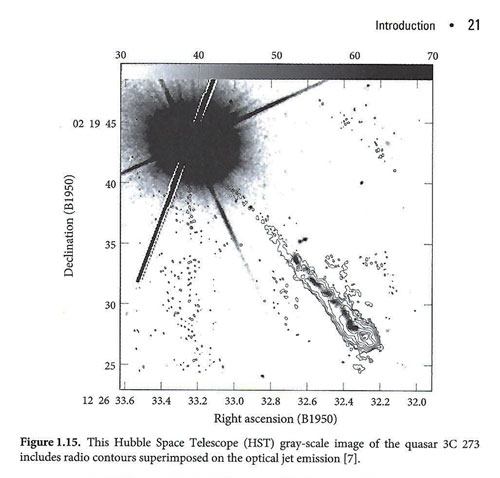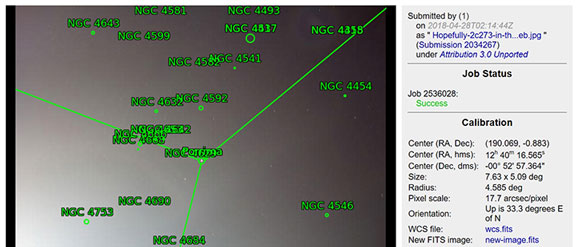Well this week I've been busy reading up on radio astronomy and just by chance reading that the brightest radio galaxy ever observed, 3c273, is also optically bright enough to be seen in just an amateur telescope. So, this became my goal, but before going into the sad news about that attempt, and being reminded of other old dreams that did not come to pass, we should cover some of the upcoming events.
Yesterday was the early bird signup deadline for the COSPAR 2018 conference in Pasadena, held on July 7-14, but I noticed today that it let me register still at the reduced rate. So, if you are still dithering about attending, check it out this weekend. Also, next month we have the ISDC conference in Los Angeles, so I hope that is already on your calendar. Separately, several of us physicist wannabes are going through the arrangement to take a tour of the Very Large Array (VLA) in New Mexico in the next several weeks. That should be fun to see that but sadly I worry sometimes that my primary interest is in seeing the local margaritas and sopapillas first and then seeing the VLA second!
Anyway, getting back to the radio astronomy studies and 3c273, take a look at this figure showing a Hubble telescope image with superimposed radio contours. Being able to see the quasar jet in radio is quite neat. Of course there is no way that the jet will show up in my image. One advantage I have over the Hubble is that the little DSLR does not generate diffraction spikes! Also, by the way, if you want to read up more on radio astronomy, the referenced text, "Essential Radio Astronomy" is a great introduction.
 |
| 3c273 figure courtesy "Essential Radio Astronomy", J. Condon and S. Ransom) |
So, after reading that 3c273 is also bright enough optically that it can be seen in small amateur telescopes I just had to try to get it. Again, rather that get out the telescope with goto mount, I elected to just try using the DSLR on a polar aligned tracking mount. As you know, I have been investigating this lightweight, easy to set up option, in lieu to getting out the bigger scope. But, take a look, what the kludgy arrangement is for using just the polar tracking mount in the photo below.
 |
| Sky-Watcher polar tracking mount on tripod with two adjustable tripod heads and DSLR (Source: Palmia Observatory) |
So, the Sky-Watcher is aligned to the north pole and will track in right ascension only. On top of that unit, I placed two adjustable tripod mounts. The first or lower mount was just so the upper mount could be mounted in a true horizontal position. This way when I want to change the altitude or azimuth of where the camera is pointing, it is easy to do because there is just one knob adjustment for azimuth and one knob adjustment for altitude. So the procedures is to set up an level on a known object and then use calculated altitude and azimuth updates to go to the target position at the proper time.
So, how do we know where to point the camera? The Sky Safari Pro screenshot below and data associated with it provide a convenient way of getting pointing angles to the target. Initially, I thought I would be able to star hop from Porrima (mag 2.7) and Zaniah (mag 3.9) to reach 3c273, but from my chosen location, it is barely possible to see Polaris (mag 2.0). So, I choose the brightest object in the sky, the Moon and calculated pointing angles from there.
 |
| Sky Safari Pro screenshot, showing the Moon and 3c273, is used to get azimuth and altitude (Source: Palmia Observatory) |
So the observing plan for this attempt to capture 3c273 was to point the camera at the conveniently positioned moon, which was up and was located just 8 degrees in altitude and 7 degrees in azimuth from 3c273. Now we know we don't like the moon anywhere near where we image, but in this case I was stuck with it. So all I had to do was get polar aligned and then move the camera off of the moon by those respective angles. The 60 second exposure from that position is shown below. There are a few bright objects in there but the skyglow is quite bad. At least the Sky tracker, even with my pure guess where Polaris was, seemed to track very well.
 |
| Tried to find 3c273 in this 150mm, 60 second, in city lights image (Source: Palmia Observatory) |
Well, the image has got a lot of sky fog showing up and the bright moon is just below the left hand bottom corner of the image. I was quite worried that I might not have made the correct changes in altitude and elevation because the top tripod mount was not able to be adjusted to be perfectly level. There was just not enough range of motion in that the various levers and adjustment knows would collide with other knobs and limits of the lower tripod mount. Oh well, let's take this image and process it through astrometry.net and see if 3c273 is anywhere in the image. NGC4493, just barely located at the top of the camera frame, and just below 3c273 in the Sky Safari screenshot, is listed as just being 1 degree lower in altitude than 3c273. Oops, the camera is pointing just about 2 degrees too low to get 3c273. Darn, and I didn't have the presence of mind to take several images, each with a slightly different turn of the tripod adjusting knobs.
 |
| What is was, was about 2 degrees too low in altitude for 3c273 (Source: astrometry.net) |
So, the camera was pointing just about 2 degrees too low in altitude to capture the location where 3c273 should be found. Darn! Should I go out the next clear night and try this all again? Hmm, maybe not. The sky glow is so bright and to get 3c273, magnitude 12.9, is going to require a bigger lens or in this case here, longer exposure times. In fact, since magnitude 6 type objects, like the moons of Jupiter, can be imaged with this same setup using just 1/2 second exposures, to capture 3c273, we would need about 600 times as much light, which corresponds to about 5-6 minutes. Umm, too much sky fog for that exposure at this city lights location.
I am beginning to realize that this goal of trying to use a lightweight mount, with all of the double tripod heads, etc., is just getting too complicated. Besides there are so many different adjustment knows and if any one of them loosens up the whole alignment will just fall away. So the lightweight part of this arrangement is a good feature, but the lack of goto capability is a drawback and trying to star hop from some set of observed stars can work in a dark sky environment, but here, I have to squint and pace back and forth just to be able to barely see the North Star, Polaris, magnitude 2.0.
Ok, so that observing session was kind of disappointing, but when I was back inside the disappointment kept coming when I spied this twitter feed from a local fusion power research lab, TAE, where I tried to help out with their needs for multi-megawatt power conversion systems. I thought it would be so neat to help out in this area of doing research in fusion power. I interviewed with them, four or five years ago, and saw their big machine, but, alas, working there was not to be for me, anyway! I hope they are making lots of progress. Fusion power, which has just around the corner for years now, maybe is now just around a much nearer corner!
 |
| TAE fusion power machine and research team (Source: TAE twitter feed) |
So, if being reminded of that old dream of mine was not enough, I happened to be talking with The Cookie Monster, Isik, at a monthly philosophy meeting, and he mentioned that he just got a hydrogen powered fuel cell car. Wow, that is pretty neat and that was another old dream of mine. I spent 5-6 years working on the development of fuel cell power plants, mostly for stationary applications, not automobiles, but nonetheless, they too, seemed to be always just around the corner; not quite ready for prime time. And yet, here is Isak standing next to his new Toyota Mirai, which gets about 312 miles to the fillup and with all of the subsidies and free hydrogen for three years it makes the economics very nice, so this corner in the fuel cell arena seems to have been turned. He says it takes about 5 minutes to fill up the tank and he really loves the car and only water comes out of the tailpipe. Thanks for sharing, Isik!
 |
| Isik shows off his Toyota Mirai with fuel cell propulsion (Source: Palmia Observatory) |
Finally, Philosopher I am, Andreas posted a photo of a sculpture that in some sense presented a possible look into and an interpretation of my internal state of mind after suffering a failure in imaging 3c273 and being reminded of my old engineering dreams that did not come to pass. Well, after all:
I didn't get an image of 3c273
I didn't get to complete the development of fuel cell power plants
I didn't get to participate in this fusion power research
Well maybe it's not all bad. That is just what a day in the life of a physicist and astronomer wannabe looks like. Tomorrow will be a new day! Yeah! Anyway, thanks for sharing that photo, Andreas!
 |
| Dejected; This guy didn't get 3c273 image or into fusion power either? (Source?: scontent-lax3-2.xx.fbcdn.net) |
Until next time,
Resident Astronomer George
There are over 200 postings of similar topics on this blog
If you are interested in things astronomical or in astrophysics and cosmology

Cosmologists have always fun and its really really interesting post.I love astronomy and space studies.I wrote an article but want to rewrite it in much better way so using http://www.rewritemyessay.net/.Its very good one site.
ReplyDeleteMy friend recommended this blog and he was totally right keep up the fantastic work! Best Vlogging Cameras
ReplyDeleteThis comment has been removed by the author.
ReplyDelete"Professional Photographers" can have prices as low as $50 for senior portraits or $5000 or more for a wedding photographer. https://photolemur.com/blog/gifts-for-photographers
ReplyDeleteThis is such a great resource that you are providing and you give it away for free. I love seeing blog that understand the value of providing a quality resource for free. Two-Way Radios
ReplyDeleteSomebody necessarily help to make seriously articles I might state. That is the very first time I frequented your web page and to this point? I surprised with the research you made to make this actual put up amazing. Fantastic task!webpage
ReplyDeleteWhen choosing a professional photographer for your photography services it is best to make your decision based on value, not just the cheapest price. Think of it like you would consider any other important purchasing decision.whiten teeth in photoshop
ReplyDeleteThat is really nice to hear. thank you for the update and good luck. preschool photographer
ReplyDeleteTook me time to read all the comments, but I really enjoyed the article. It proved to be Very helpful to me and I am sure to all the commenters here! It’s always nice when you can not only be informed, but also entertained! best telescope for planets
ReplyDeleteThis is the type of information I’ve long been trying to find. Thank you for writing this information. get instagram likes free app ios
ReplyDelete